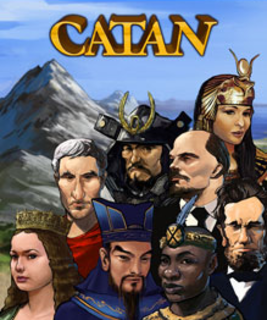Combining both rich gameplay and social affair, Catan manages to hold an entertaining experience.
The rules of Catan can be little overwhelming at first play. You and your fellow opponents are set on an island that is divided into several numbered hexagonal tiles. Each tile is individually represented by one of the five available resources: ore, wool, grain, brick and lumber. To accumulate these resources, each player roll dice at the beginning of their turn. If the dice correspond with a resource tile's number, players who own adjacent properties to that tile receive one resource card. You can use these cards to build property such as roads, settlements, and cities, or you can use them to buy development cards. All of these actions will eventually end up in earning you victory points, and the first to 10 points win.
Although everyone is out to get 10 victory points as fast as possible, you won't get very far in Catan without working together to trade for your needed cards first. Trading is a very simple process to perform, as there is an easy interface at hand. You simply show what card you want, what card you're willing to give and the other players will either accept or deny. While it may sound simple, it is silently complex at the same time; a certain card may be a road to you, but it may mean a city for them. Alternatively, you can either wait for your turn to come around again, or you can use the port option to trade a number of resources for one certain other. Because there are many available ways to get a hold on the card that you want, the game doesn't feel overly dependent on waiting for your numbers to be rolled all of the time--and that's good.
Obviously, trading isn't the only strategy required. Catan seems to reward those who plan smart and think ahead. At the same time, you don't necessarily need a GED to make some good moves; there are a half-dozen different ways to score victory points. Each settlement you build will offer a point, and eventually upgrading them to a city will give you another. Individual road placements won't reward you with any points, but if you happen to have the longest road compared to others, you'll earn two points. Playing three soldier cards, which you get by trading resources for a development card, will give you another two points. There are also development cards that will give you victory points just for the sake of having them. Since there are only a handful of different ways to earn these victory points, you will have to try out different approaches to beat out your opponents. At the end of the day, no set strategy is going to guarantee you a win every time. The number and resource tile placements on the board are always random each game, which helps drain out any monotony and pushes you to try other strategies more often.
Focusing on your strategy can potentially blindside you from seeing things that could go wrong. You're constantly fighting off the robber; a game piece that can be moved onto a tile when a 7 is rolled or a soldier card is played, which then stops that tile from producing resource cards. Many other unpredictable moments can happen that can ruin your plans that could make you shift your strategy around. Unfortunately, the same unpredictability-ness of the A.I. is also its downfall. While easy feels too simple and overly generous when trading, higher difficulty modes feel rather fixed. Dice rolls are obviously one-sided to the computers favor, and robbers will always be placed on your territory. It definitely has a cheap taste to it, and although Catan should be played online, it's no excuse for bamboozled singleplayer.
Of course, you won't be staring at trade screens all day. Graphically, the game comes in two different skins. The first skin is a simplistic board that is similar to the real deal. Although it doesn't shine too much light, what it offers is a very clean, easy-going style. Alternatively, the other mode is full of 3D glory. Mines of ore are now sticking out, sheep can be seen eating, and the shore can be seen gently crashing into the beach. While this mode may take you a little while to get used to, and if its busy approach doesn't throw you off, you'll never see yourself going back. The audio itself comes about a nice looping tune that doesn't quite tire out, and thanks to its pompous-like style, you always feel as if you need to adjust that pretend periwig.
Catan may not appeal to everyone, as its slow pace isn't too attracting and the 800-point price tag might seem a little steep for a board game. However, its rules surely are accessible to nearly everyone of age. While it may not offer anything past a good-hearted board game, Catan does what it tries to do very well; which is to provide an entertaining, socialized experience.

